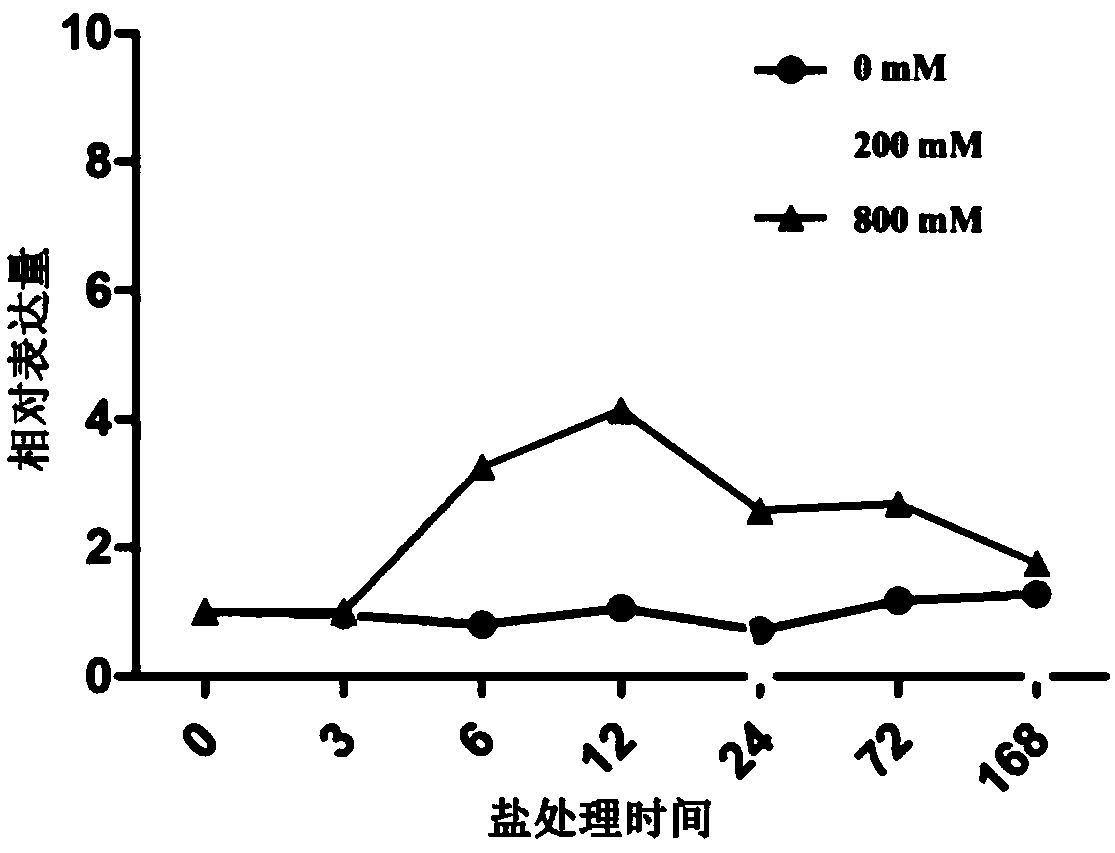Salicornia europaea SePSS protein, and coding gene and application thereof
A coding gene and coding technology, applied in the fields of application, genetic engineering, plant genetic improvement, etc., can solve problems such as cell osmotic stress, ion balance disruption, poisoning, etc.
- Summary
- Abstract
- Description
- Claims
- Application Information
AI Technical Summary
Problems solved by technology
Method used
Image
Examples
Embodiment 1
[0076] Embodiment 1, discovery of Salicornia sePSS protein and its coding gene
[0077] Total RNA was extracted from aerial parts of Salicornia praecox and reverse transcribed into cDNA. After a large number of sequence analysis, expression analysis and functional verification, a DNA coding sequence of phosphatidylserine synthase was found from cDNA, as shown in sequence 2 of the sequence listing, and its encoded protein is shown in sequence 1 of the sequence listing .
[0078] The protein shown in Sequence 1 of the sequence listing is named SePSS protein, which consists of 425 amino acid residues, and has nine transmembrane domains without signal peptide. The gene encoding SePSS protein is named as SePSS gene, and its full-length CDS is 1728bp.
Embodiment 2
[0079] Embodiment 2, the expression analysis of SePSS gene
[0080] After 30 days of sowing Salicornia seeds, the seedlings with consistent growth were taken and cultured for different time (0, 3, 6, 12, 24, 72 or 168 hours), and the aerial parts were taken for gene expression detection.
[0081] Extract the total RNA from the aerial part, reverse transcribe it into cDNA, use the cDNA as a template, and use real-time quantitative PCR (Real-time quantitative PCR, qRT-PCR) to detect the expression of SePSS gene (use primers SePSS-qPCR-Forward and The primer pair composed of primer SePSS-qPCR-Reversed was used for detection), and the α-tubulin gene was used as an internal reference (the primer pair composed of primer α-tubulin-qPCR-Forward and primer α-tubulin-qPCR-Reversed was used for detection).
[0082] α-tubulin-qPCR-Forward: 5'-CGAAAGTTGGGGGCTCGAAG-3';
[0083] α-tubulin-qPCR-Reversed: 5'-CCCCGGAACCCAAAGACTTTG-3';
[0084]SePSS-qPCR-Forward: 5'-GCGATGATGCTCGGTTGTTC-3'; ...
Embodiment 3
[0087] Example 3, SePSS protein subcellular localization
[0088] 1, pCAMBIA1300-35S::SePSS-GFP carrier: Insert the double-stranded DNA molecule described in Sequence 2 of the sequence listing between the BamHI restriction sites of pCAMBIA1300-35S::GFP vector to obtain pCAMBIA1300-35S::SePSS- GFP vector (sequenced and verified).
[0089] 2. pCAMBIA2300-35S::HDEL-mCherry vector: use the double-stranded DNA molecule described in sequence 3 (HDEL-mCherry fragment) of the sequence listing to replace the fragment between the SalI and HindIII restriction sites of the pCAMBIA2300 vector to obtain pCAMBIA2300- 35S::HDEL-mCherry vector (verified by sequencing).
[0090] 3. Introduce the pCAMBIA1300-35S::SePSS-GFP vector into C58 Agrobacterium to obtain recombinant bacteria 35S::SePSS-GFP. The recombinant bacteria 35S::SePSS-GFP was inoculated in LB liquid medium containing 20μM AS, 10mM MES, 100μM Kan and 100μM Rif and shaken (28°C, 180rpm) to OD 600 = 1.8. After the culture system...
PUM
 Login to View More
Login to View More Abstract
Description
Claims
Application Information
 Login to View More
Login to View More - R&D
- Intellectual Property
- Life Sciences
- Materials
- Tech Scout
- Unparalleled Data Quality
- Higher Quality Content
- 60% Fewer Hallucinations
Browse by: Latest US Patents, China's latest patents, Technical Efficacy Thesaurus, Application Domain, Technology Topic, Popular Technical Reports.
© 2025 PatSnap. All rights reserved.Legal|Privacy policy|Modern Slavery Act Transparency Statement|Sitemap|About US| Contact US: help@patsnap.com



